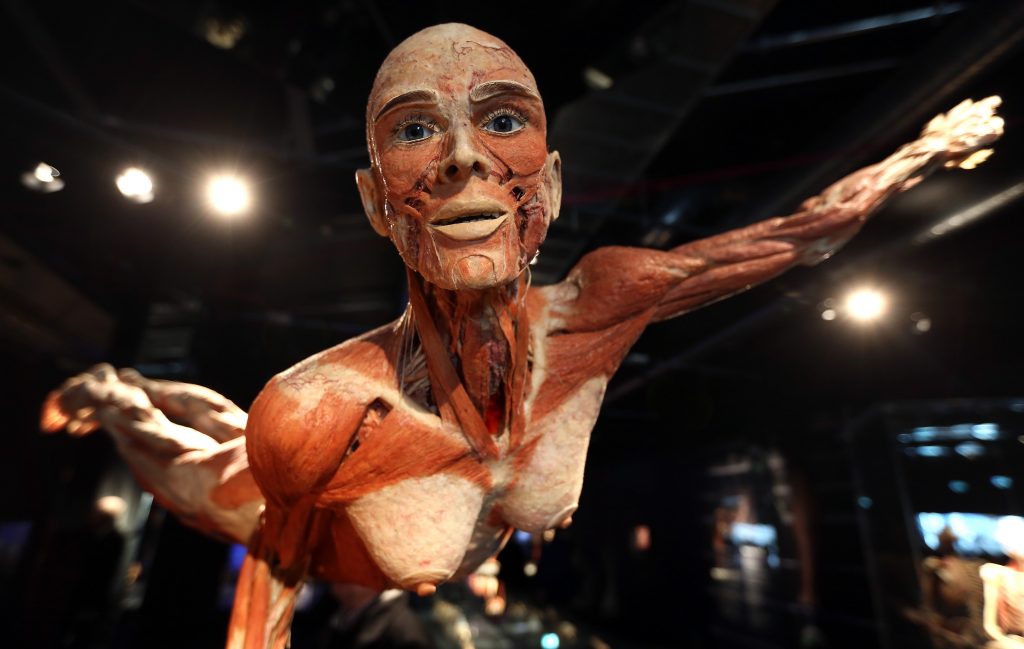Ash, Diamonds, Stones, Trees, Compost, Effluent, or … Plastic?
Of all potential methods of final disposition, this one may qualify as the most “21st Century.” Plastination is the process of converting flesh to plastic by replacing a body’s fluids with a curable polymer — a process that can take weeks, even months, depending on the size of the specimen and type of polymer used. Once treated, the body won’t decompose, requires virtually no maintenance, and is odor free. It will retain the natural contours of the original specimen, remain anatomically intact, and maintain its original appearance.
There’s no exposure to harsh chemicals and, carefully handled, durable specimens last decades.

How It’s Done
There are two versions of the process, and they work essentially the same way. The first takes place at a temperature of -20 C (-4 F); the second at room temperature. The main difference between the two is in the type of polymer used. Silicone, polyurethane, epoxy, and polyester (!) are common options.
Either process, in a nutshell, looks like this:
1: Dissection of the specimen.
2: Specimen washed and bleached,
3: Specimen dehydrated in acetone,
4: Submerged in a vacuum chamber filled with polymer,
5: Acetone drawn out via vacuum; polymer simultaneously drawn in, replacing the acetone
6: Specimen removed.
7: Excess polymer allowed to drain (may take days, weeks, or months depending on the size of the specimen and the amount of polymer (think plastinated human fetus vs. plastinated shark or elephant).
8: Specimens are then posed and treated with a catalyst to set the polymer
When handled with care, polymerized specimens can last decades. There’s no attendant mess of the sort that accompanies wet specimens and no danger of exposure to toxic chemicals.
Exhibits

There are a number of international exhibits active where one can see multiple specimens of plastinated bodies of human adults, fetal tissue, and animals. The most famous and longest-standing is Body Worlds. To inquire about making body donations, contact Body Worlds here or download their body donation brochure here.
US Plastination Laboratories
Currently, there are eight laboratories in the US capable of the plastination process, largely affiliated with universities. Most facilities present the usual “intended for educational purposes” disclaimer — even the internationally travelling original German exhibit.
Some of the plastination labs in the US accept body donations:
- Bryan College of Health Sciences – 1535 S. 52nd St. Lincoln, NE 68506 PH: 402-481-3801
- Eastern Virginia Medical School Eastern Virginia Medical School – Pathology and Anatomy, P.O. Box 1980, Norfolk, VA 23501-1980 PH: 757.446.5620
- Grand Velley State University Biomedical Sciences Department, 212 Henry Hall, 1 Campus Drive, Allendale, Michigan 49401 PH: (616) 331-3318 biomeddept@gvsu.edu
- MI Plastination Lab P.O. Box 635, Freeland, MI 48623 Email: info@miplastinationlab.com PH: 989-545-1007
- Orange Coast College 2701 Fairview Road, Costa Mesa 92626 PH: 714-432-5772
- Union University (1050 Union University Dr, Box 1801
Jackson, TN 38305 Director Robert A. Wamble rwamble@uu.edu 731-661-6518) - U Colorado – Building 500, Suite N5200, 13001 E 17th Place
Aurora, CO 80045 Email: alison.grice@cuanschutz.edu - U Toledo (2801 W. Bancroft • Toledo, OH 43606 • 1.800.586.5336)
Thanks to Connecting Directors contributing author Jennifer Trudeau for this fascinating story!




